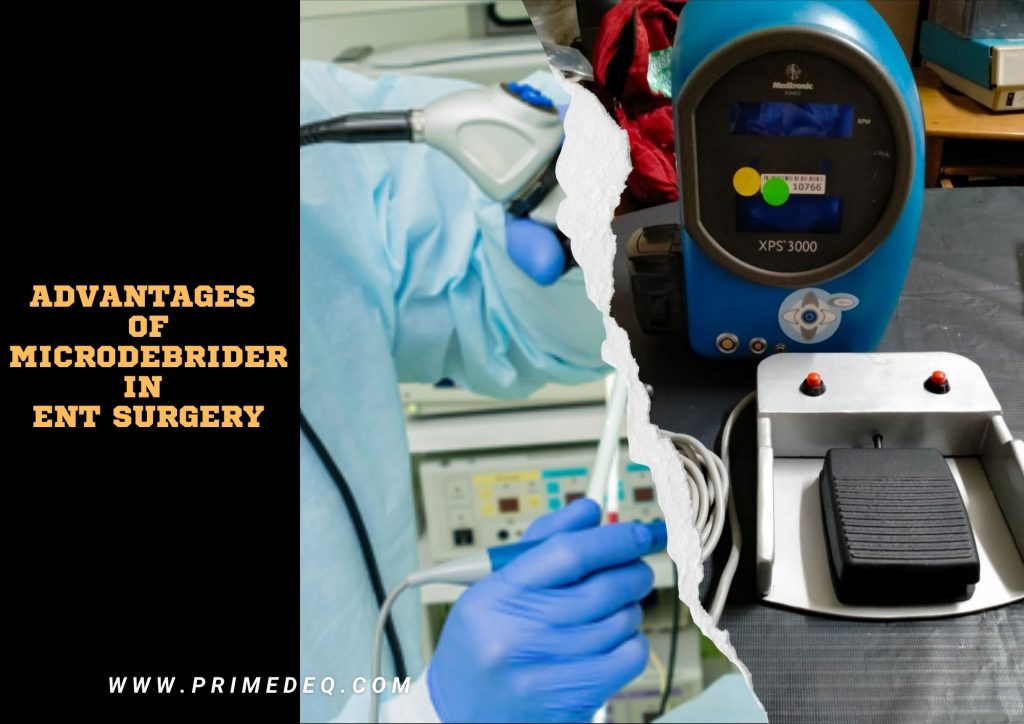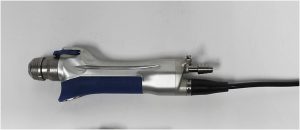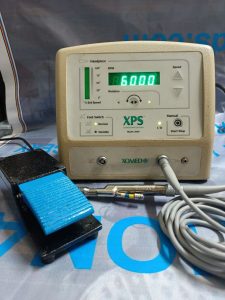
Microdebrider is one of the most useful technical developments that have been brought into the field of rhinology after using in fields like orthopaedics and plastic surgery. It is in use in nasal and endoscopic sinus surgeries and tonsillectomies for the last few decades. Advantages of microdebrider are shorter, precise and less traumatic surgery for the patient.
Three key components of a microdebrider
The microdebrider is a tubular instrument with a hollow tube. At the tip of the tube is the blade that cuts tissue that need to be removed, as the blades move back and forth. The faster the blades move, the smaller the cut pieces will be. While if blades move slower, it will cut larger pieces. The size of the cut tissues are good enough to be used for histopathology etc. The blade is integrated with a suction mechanism to continuously pull the tissue to be cut and removed from the surgical area.
There are three main components of the microdebrider.
- Blade (or bit) – is a hollow metal tube, which is serrated or smooth, with a port for suction. The suction operation pulls tissue to the aperture of the blade, which then cuts it. The blades design ensures cutting of tissue and simultaneous removal from the site through suction. Blades come in various sizes. They are disposable and need to be replaced for every use. Blades can be rotated in forward, reverse, or oscillating modes at various speeds.
Recent developments in blades are inclusion of cautery function and also longer blades. Bipolar blades e.g. also help with cauterization or coagulation simultaneously. The advantage is less bleeding, cleaner, efficient surgery. Essentially these blades can perform all three functions i.e cut, suction and cauterization/ coagulation.
Longer blades help in reaching deeper lesions and tissues.
- Handpiece – The handpiece holds and controls the blade and suction operation, so as to allow for rapid and simultaneous removal of debris and provide better visibility to the surgeon for further operation. The handpiece can hold blades of various sizes and configurations. Suction tubing connects to the handpiece.
- Console (operated by a foot pedal) – the speed and direction of the rotating blade is set by the surgeon using a foot pedal and the parameters are displayed on a console.
Most common surgical instruments used for sinus surgery are:
- Cannulas
- Chisels and Rasps
- Curettes
- Elevators
- Forceps
- Hooks
- Picks and Knives
- Needles and Needle Holders
- Osteotomes
- Probes
- Punches and Rongeurs
- Retractors – hand held and fiberoptic
- Scissors – traditional and supercut
- Speculums
- Suction Tubes
- Trocars
Sinus surgery, before the use of microdebriders, were done using curettes and forceps. This was essentially a manual method for extracting bone and tissue from the nasal and sinus cavities. Power drills are also used alternately. In practice, even now, surgeons use a combination of curettes, microdebriders, and forceps, depending on the case at hand.
What are the advantages in using a microdebrider?
Microdebriders have many advantages:
- Reduced surgery time: A microdebrider does not reduce the risk of bleeding, but continuous suction clears the surgical site and hence keeps the surgeon’s view clear during the surgery. This means the surgeon wastes less time swapping instruments and hence the overall surgery is more time efficient. If cauterization is part of the instrument, then we have even lesser blood loss and faster surgery.
- Variety of tips for better access and accuracy – Depending on the type of procedure being performed different types of tips can be used. E.g. pre-bent tips, which allow for easier access to difficult surgical locations (like in paranasal sinuses). Some tips also allow for 360-degree rotation (like the Straightshot M4), which allows for more accurate approaches to the tissue to be removed.
- Adjustable Blades for better precision – Various kinds of blades can be used. Straight-edged blades are more precise and can be less traumatic than other blades. While serrated blades provide a better grip for the surgeon. One can change the speed at which the blades are used for better precision of cutting as well as to cut bone.
Compared to traditional tools, microdebrider and blades are a costlier affair. However, if used with proper training and caution, microdebriders result in shorter, precise and less traumatic surgeries for the patient.
Microdebriders popularly in use are – Medtronic Xomed XPS 2000, Medtronic Xomed XPS 3000, Medtronic Straightshot M4 & M5 microdebriders. Other popular brands are Olympus, Stryker, Naugra, Karl Storz, Brainlab, Smith & Nephew etc.
——————————————————————————————————————————
PrimedeQ is an e-Marketplace for buying, selling, renting, servicing and spares of medical equipment. We offer all types of used / refurbished medical equipment , including ENT equipment, Laparoscopic Equipment, Lab equipment, X-Ray, TMT, ECG, anesthesia machine, ultrasound machines etc. WE offer microdebrider, laparoscope , endoscope and ultrasound probe repair services etc.
https://in.linkedin.com/in/shanthi-mathur-ab07838


